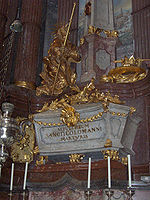Coloman of Stockerau
Saint Coloman | |
|---|---|
 | |
| Born | 10th century Ireland |
| Died | October 18, 1012 Stockerau |
| Venerated in | Roman Catholicism |
| Major shrine | Abbey of Melk |
| Feast | September 2 |
| Attributes | pilgrim monk with a rope in his hand; depicted being hanged on a gibbet; tongs and rod; priest with a book and maniple. |
| Patronage | Austria; Melk; patron of hanged men, horned cattle, and horses; invoked against plague and for husbands by marriageable girls; invoked against hanging; invoked against gout[1] |
Saint Coloman (Koloman, Colman, Colomannus) of Stockerau (of Melk) (died October 18, 1012) is a saint of the Catholic Church. He was a monk of either Irish or Scottish origin and of royal lineage who was accused of being a spy while on penitential pilgrimage to Jerusalem. He was stopped and killed at Stockerau, which lies about fifteen miles from Vienna, at a time when there were continual skirmishes among Austria, Moravia, and Bohemia.
Coloman spoke no German, so he could not give an understandable account of himself. He was hanged to death alongside several robbers after he was tortured.
Veneration

In 1015, his relics were transferred to the Abbey of Melk by Bishop Megingard at the request of Marquis Saint Henry of Austria. Coloman became the object of a popular cult and many churches and chapels in Austria, Swabia, the Palatinate, Hungary, and Bavaria are dedicated to him. He is also venerated in Ireland.
A legend states that Coloman's body remained incorrupt for eighteen months, and remained undisturbed by birds and beasts. The scaffolding itself is said to have taken root and to have blossomed with green branches, one of which is preserved under the high altar of the Franciscan church at Stockerau.
